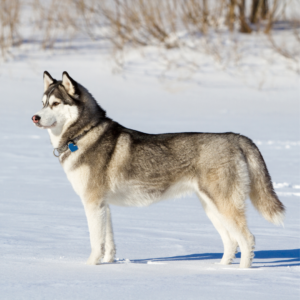The Siberian Husky: A Majestic and Spirited Arctic Companion
Introduction:
The Siberian Husky, with its striking wolf-like appearance and friendly demeanor, is a captivating dog breed that hails from the harsh Arctic regions. Renowned for its endurance, intelligence, and striking blue eyes, the Siberian Husky has become a popular breed for both sled dog racing and family life. In this article, we’ll explore the history, characteristics, temperament, care requirements, and notable contributions of the Siberian Husky.
History:
The Siberian Husky’s roots trace back to the Chukchi people of Siberia, who developed the breed to pull sleds across long distances in the challenging Arctic environment. Bred for endurance and strength, these dogs played a crucial role in the survival of the Chukchi people. The Siberian Husky was later introduced to Alaska in the early 20th century during the Nome Gold Rush.
The breed’s striking appearance and friendly nature quickly gained popularity, leading to its recognition by the American Kennel Club (AKC) in 1930. Today, Siberian Huskies are not only treasured for their working abilities but also for their adaptability to various lifestyles.
Physical Characteristics:
1. **Size:**
– Height: 20 to 24 inches at the shoulder
– Weight: 35 to 60 pounds
2. **Coat:**
– Thick double coat with a soft, dense undercoat and a straight, harsh outer coat
– Colors include black, gray, red, and agouti, often with distinctive facial masks and striking markings
3. **Eyes:**
– Almond-shaped, medium-sized, and can be blue, brown, green, or amber, often with heterochromia (two different-colored eyes)
Temperament:
Siberian Huskies are known for their friendly and outgoing temperament. They are social dogs that enjoy the company of their human family and other dogs. The breed is often described as mischievous, intelligent, and independent, with a love for play and exploration.
While Siberian Huskies are generally good with children, early socialization is essential to ensure they develop appropriate behaviors. Their strong prey drive and independent nature can make recall challenging, so a secure and well-fenced environment is crucial.
Care Requirements:
1. **Exercise:**
– Siberian Huskies are energetic and require regular exercise to keep them physically and mentally stimulated. Activities such as running, hiking, and interactive play are essential to prevent boredom.
2. **Grooming:**
– The breed sheds heavily, especially during seasonal changes. Regular brushing helps manage shedding and keeps the coat healthy. Siberian Huskies are generally clean dogs and do not have a strong odor.
3. **Training:**
– Early and consistent training is important for Siberian Huskies. Their intelligence and independent nature require positive reinforcement-based training methods. Patience and a sense of humor are beneficial when working with this spirited breed.
4. **Nutrition:**
– Providing a well-balanced and nutritious diet is important for the overall health of Siberian Huskies. Monitoring their weight and adjusting their diet based on factors such as age and activity level is essential.
Notable Contributions:
Siberian Huskies have made notable contributions as working dogs in sled dog racing, particularly in events like the Iditarod and the Yukon Quest. Their endurance, strength, and ability to navigate harsh Arctic conditions make them well-suited for these demanding races. Additionally, their friendly disposition has endeared them to families around the world as loving and active companions.
Conclusion:
The Siberian Husky, with its majestic appearance and spirited personality, is a breed that continues to captivate dog enthusiasts globally. Whether as a working sled dog or a beloved family pet, the Siberian Husky’s unique blend of intelligence, endurance, and friendliness makes it a truly exceptional canine companion.


Leave a Reply